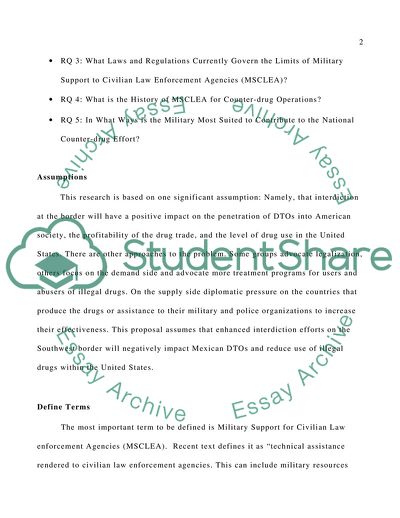Cite this document
(Military Capabilities Against Mexican Drug Trafficking Organizations Research Proposal, n.d.)
Military Capabilities Against Mexican Drug Trafficking Organizations Research Proposal. https://studentshare.org/military/1745977-i-am-planning-to-write-my-capstone-project-for-my-masters-on-8213should-additional-us-military-capabilities-be-brought-to-bear-against-mexican-drug-trafficing-organizations-dto-to-increase-counterdrug-effectiveness-along-the-us-mexico-border
Military Capabilities Against Mexican Drug Trafficking Organizations Research Proposal. https://studentshare.org/military/1745977-i-am-planning-to-write-my-capstone-project-for-my-masters-on-8213should-additional-us-military-capabilities-be-brought-to-bear-against-mexican-drug-trafficing-organizations-dto-to-increase-counterdrug-effectiveness-along-the-us-mexico-border
(Military Capabilities Against Mexican Drug Trafficking Organizations Research Proposal)
Military Capabilities Against Mexican Drug Trafficking Organizations Research Proposal. https://studentshare.org/military/1745977-i-am-planning-to-write-my-capstone-project-for-my-masters-on-8213should-additional-us-military-capabilities-be-brought-to-bear-against-mexican-drug-trafficing-organizations-dto-to-increase-counterdrug-effectiveness-along-the-us-mexico-border.
Military Capabilities Against Mexican Drug Trafficking Organizations Research Proposal. https://studentshare.org/military/1745977-i-am-planning-to-write-my-capstone-project-for-my-masters-on-8213should-additional-us-military-capabilities-be-brought-to-bear-against-mexican-drug-trafficing-organizations-dto-to-increase-counterdrug-effectiveness-along-the-us-mexico-border.
“Military Capabilities Against Mexican Drug Trafficking Organizations Research Proposal”. https://studentshare.org/military/1745977-i-am-planning-to-write-my-capstone-project-for-my-masters-on-8213should-additional-us-military-capabilities-be-brought-to-bear-against-mexican-drug-trafficing-organizations-dto-to-increase-counterdrug-effectiveness-along-the-us-mexico-border.


